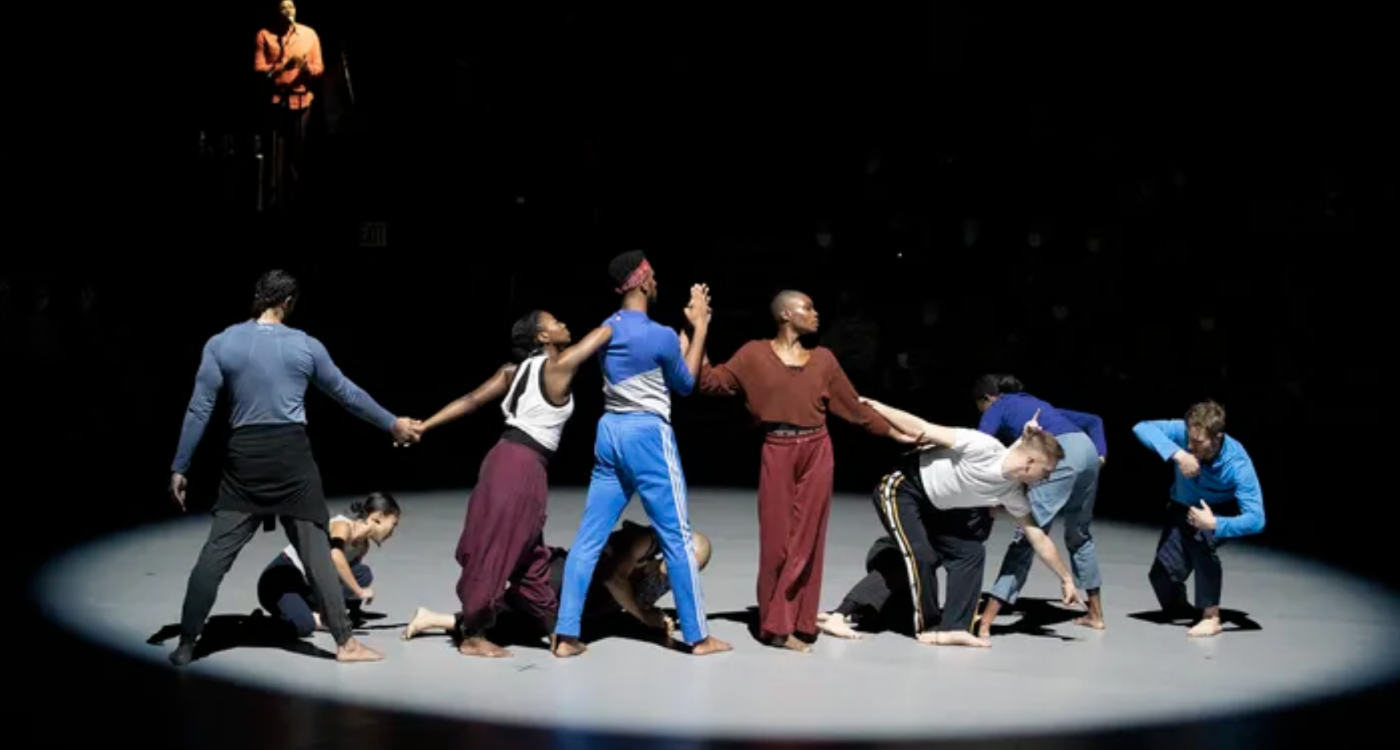Bill T. Jones/Arnie Zane Company unveils new piece at the Mann Center

"Deep Blue Sea," conceived and directed by Bill T. Jones, is performed at the Mann Center on Friday by the Bill T. Jones/Arnie Zane Company. The performance involved the spoken word, dancers, a choir and projected images and light effects.Read more
The performance was also the public debut of a new black-box-type space that puts both performers and audience on the main stage.
by Peter Dobrin | The Philadelphia Inquirer
Blood-red in spray-paint-like font, the words are projected onto the stage at a certain point in Deep Blue Sea: “How’s it feel to be a problem?” Words grow to become blobs, and suddenly the whole stage is engulfed in crimson. Two dancers, Barrington Hinds and Marie Lloyd Paspe, writhe energetically into each other’s form — a reclaiming of the bloodbath atmosphere in a pas de deux of incredible agency and beauty.
Bill T. Jones does this over and over — raising moments of hope from despair — in Deep Blue Sea, which had its pandemic-delayed local premiere Friday night at the Mann Center. At 70, Jones is revered as a grand old man of dance, and yet this new work, commissioned by the Mann, couldn’t be more au courant. Jones himself is ever-present in the piece as speaker and dancer, but it’s through his larger role as creative catalyst for a cast of dancers, musicians, light artists, and others that Deep Blue Sea gets its edge.
What degree of control Jones exercised over all of the multimedia aspects isn’t known and isn’t necessarily relevant to the audience, but the overall feeling was that of a wise influence letting the artists do what they do best.
Jones establishes an unlikely narrative device that recurs in the 100-minute-plus piece. He tells the story of how, as a schoolboy, he studied Moby-Dick, and how later in life he revisited the story and stumbled on the question of Pip, the Black cabin boy.
“We don’t remember him. Why?” Jones asks.
Pip gets left behind in the story, a lost, bobbing figure in the sea, and the metaphor for Black America is no less powerful for being obvious. The terror of being separated from humanity is more than one can bear. A lone countertenor is heard, a small chorus joins in, and the 10 dancers of the Bill T. Jones/Arnie Zane Company roll across the stage, moving and trembling like a wave before the darkness swallows up Pip.
Jones is the convener of at least a half dozen art forms and genres in Deep Blue Sea, all brought together in a venue of great intimacy that’s new to Fairmount Park. Performers and a small audience (about 275) are both on the main stage in this new configuration, dubbed Downstage @ the Mann, with an added black curtain at the stage’s edge completing the enclosure. Sophisticated light projections flicker and move across the stage floor, amplifying the message. When a spotlight on a dancer suddenly turns into a black circle, effectively erasing a person, you feel it.
Humanity erased, characters forgotten, people violated — Deep Blue Sea is above all a piece of social justice theater, and Jones acts as a kind of sage poet on its behalf. “Revolution is not a onetime thing,” he says, echoing writer-activist Audre Lorde. He invokes police brutality and Jan. 6, suggesting that his piece has only gained power and relevance since the originally scheduled premiere in 2020 was thwarted by the pandemic.
It’s the fact that so much of Deep Blue Sea is sophisticated and complex that makes one moment stand out as somewhat superimposed. Two microphones are placed on stage near the end, and one by one the professional as well as community dancers walk up and give testimony on things they believe about race, equality, and other matters.
Elsewhere, and densely packed, the synergies were elegantly constructed and potent. Bright, agile images of text and human faces move across the stage. The design by Elizabeth Diller (of the New York architecture firm Diller Scofidio + Renfro) and Peter Nigrini didn’t just provide a changing dance floor, but one that often interacted with the dance. Original music by Nick Hallett, a small choir, and a substantial contribution of other sound design — combined with the tight “black box” configuration — made the Mann, and the outside world, disappear.
All the better to focus on the dance, which, both in its individual and ensemble work, was stunning in seamlessly drawing on traditional ballet moves as well as modern gestures. Jones moves bodies around the stage like sculptures — even nonprofessional ones. He carried the sea-of-humanity idea into the end of the work, where a few dozen dancers became a tight, bubbling whirlpool.
Surely one of the most arresting moments comes near the middle of the piece, where a projection turns the entire floor into an ocean. It’s a breathtaking image, but also vast and desolate, and raises a troubling ambiguity. Whom have we left behind in the here and now? Beauty and horror don’t contradict or mitigate each other in Bill T. Jones’ world. Often they simply coexist on a knife’s edge, raising the hope or fear that someday one may convert the other to its cause.